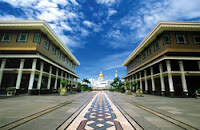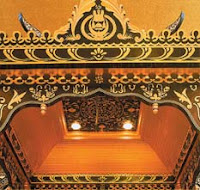Yayasan Hassanal Bolkiah Complex
brief History of Brunei Darussalam historyThere is archaeological evidence that early modern humans were present in Borneo 40,000 years ago. These early settlers were later replaced by successive waves of Austronesian migrants, whose descendants form the many ethnic and cultural groups living in Borneo today, alongside more recent immigrants from China, Indonesia, the Philippines and India.
Interior in Brunei Palace
Early Borneo kingdoms were under the cultural, economic and political influence
of larger Hindu and Buddhist kingdoms in the Indonesian archipelago. There is
evidence of early trade with India and China dating as far back as the 6th
century, with a rich trade in camphor, spices, precious woods and exotic jungle
products in the area that is now modern-day Brunei.The rise of the Sultans: The Empire of Brunei
Trade with the Arabian Peninsula and with Indian Muslim traders saw the introduction of Islam to Brunei. In 1405, Brunei’s monarch embraced Islam and ruled as Sultan Muhammad, founding a dynasty which continues today. Brunei’s monarchy has the distinction of being the oldest unbroken reigning dynasty in the world.
Brunei’s sovereignty peaked in the 15th and 16th centuries, when it controlled the whole of Borneo and parts of the Philippines. The empire’s vast wealth, derived from international commerce, created a strong impression on early European explorers. They returned to Europe with stories of gold, regalia and majestic ceremonies.
Europeans Arrive
In later centuries, declining trade and colonial intrusions eroded the size and influence of Brunei, especially after the 1839 arrival of James Brooke. A swashbuckling English adventurer, James Brooke was appointed governor, or Rajah, of Sarawak, after helping the Sultan put down a rebellion. However, he soon consolidated power and started expanding the territory under British control, creating his own dynasty of “White Rajahs” that ruled until World War II.
During their rule, the “White Rajahs” continued encroaching on Brunei’s territory, which was also under pressure from British trading companies which had already taken control of present-day Sabah state in Malaysia.
These and other internal disputes prompted the Sultan to accept British protection and control over external affairs. In 1906, Brunei submitted to a British Resident system, giving the British control over home affairs, except for customs and religion. Reduced to a fraction of its former size and wealth, Brunei saw a revival of its fortunes when oil was discovered in 1929. The resulting wealth was judiciously managed and sustained, even during the nation’s occupation by the Japanese during WWII. Following the war, it was the late Sultan Omar ‘Ali Saifuddien, the true architect of modern Brunei, who set Brunei on its course to modernization.
Modern, Independent Brunei
Today’s Sultan, His Majesty Sultan Haji Hassanal Bolkiah, the 29th ruler of his line, led Brunei Darussalam to its independence from the British in 1984. During His Majesty’s reign, a fast-paced modernization program, building upon the nation’s oil wealth, has resulted in a noted improvement in quality of life for all Bruneians. Now leading the nation into the 21st century, His Majesty’s government is responsible for the booming construction and infrastructure expansions which have turned Brunei into one of Southeast Asia’s most developed nations. Attracting foreign investment, improving the nation’s human resources base, and tourism development are all measures that His Majesty and the government are promoting to prepare the nation for the challenges of the future, when oil and gas reserves will have been depleted and a diversified economy will be needed to maintain the high standards of living currently enjoyed by the Bruneian people
Source :
http://www.bruneitourism.com/






Brief History Of Brunei Darussalam
ReplyDelete